FIAT DOBLO COMBI 2013 Owner handbook (in English)
Manufacturer: FIAT, Model Year: 2013, Model line: DOBLO COMBI, Model: FIAT DOBLO COMBI 2013Pages: 283, PDF Size: 6.31 MB
Page 141 of 283
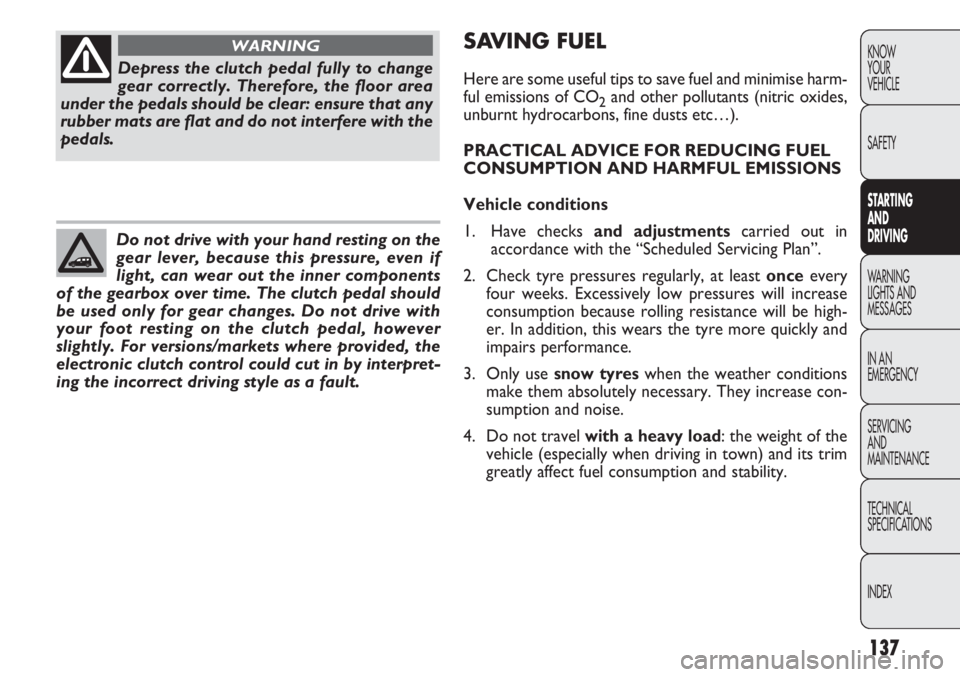
137
KNOW
YOUR
VEHICLE
SAFETY
STARTING
AN
D
DRIVING
WARNING
LIGHTS AND
MESSAGES
IN AN
EMERGENCY
SERVICING
AND
MAINTENANCE
TECHNICAL
SPECIFICA TIONS
INDEX
Depress the clutch pedal fully to change
gear correctly. Therefore, the floor area
under the pedals should be clear: ensure that any
rubber mats are flat and do not interfere with the
pedals.
WARNING
Do not drive with your hand resting on the
gear lever, because this pressure, even if
light, can wear out the inner components
of the gearbox over time. The clutch pedal should
be used only for gear changes. Do not drive with
your foot resting on the clutch pedal, however
slightly. For versions/markets where provided, the
electronic clutch control could cut in by interpret-
ing the incorrect driving style as a fault.
SAVING FUEL
Here are some useful tips to save fuel and minimise harm-
ful emissions of CO
2and other pollutants (nitric oxides,
unburnt hydrocarbons, fine dusts etc…).
PRACTICAL ADVICE FOR REDUCING FUEL
CONSUMPTION AND HARMFUL EMISSIONS
Vehicle conditions
1. Have checks and adjustments carried out in
accordance with the “Scheduled Servicing Plan”.
2. Check tyre pressures regularly, at least once every
four weeks. Excessively low pressures will increase
consumption because rolling resistance will be high-
er. In addition, this wears the tyre more quickly and
impairs performance.
3. Only use snow tyres when the weather conditions
make them absolutely necessary. They increase con-
sumption and noise.
4. Do not travel with a heavy load: the weight of the vehicle (especially when driving in town) and its trim
greatly affect fuel consumption and stability.
Page 142 of 283
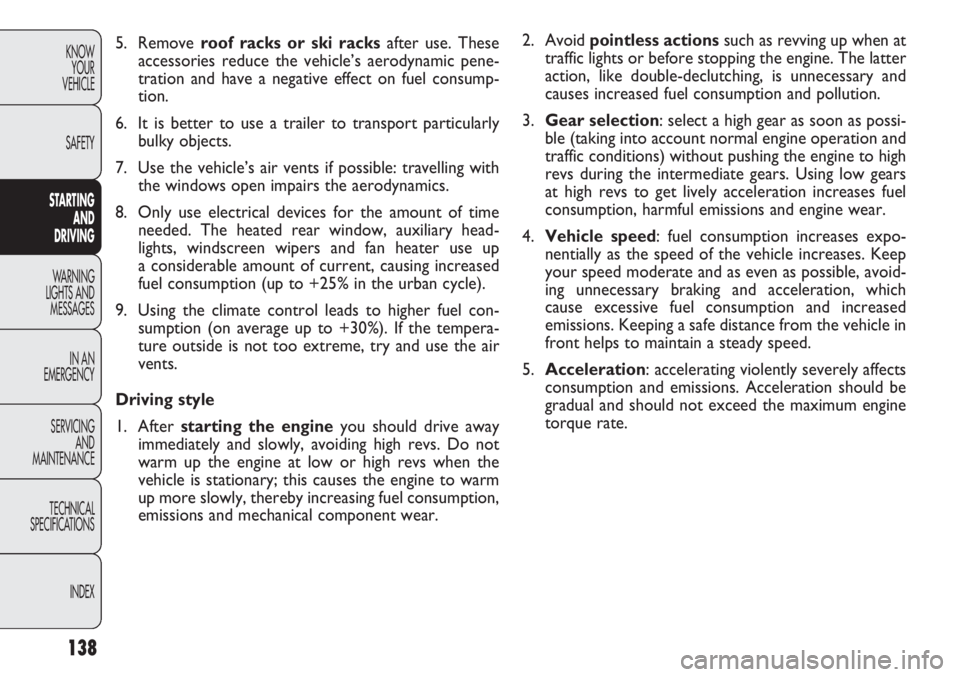
138
KNOWYOUR
VEHICLE
SAFETY
ST ARTING
AN
D
DRIVING
WARNING
LIGHTS AND MESSAGES
IN AN
EMERGENCY
SERVICING AND
MAINTENANCE
TECHNICAL
SPECIFICA TIONS
INDEX
2. Avoid pointless actions such as revving up when at
traffic lights or before stopping the engine. The latter
action, like double-declutching, is unnecessary and
causes increased fuel consumption and pollution.
3. Gear selection: select a high gear as soon as possi-
ble (taking into account normal engine operation and
traffic conditions) without pushing the engine to high
revs during the intermediate gears. Using low gears
at high revs to get lively acceleration increases fuel
consumption, harmful emissions and engine wear.
4. Vehicle speed: fuel consumption increases expo-
nentially as the speed of the vehicle increases. Keep
your speed moderate and as even as possible, avoid-
ing unnecessary braking and acceleration, which
cause excessive fuel consumption and increased
emissions. Keeping a safe distance from the vehicle in
front helps to maintain a steady speed.
5. Acceleration: accelerating violently severely affects
consumption and emissions. Acceleration should be
gradual and should not exceed the maximum engine
torque rate.
5. Remove
roof racks or ski racks after use. These
accessories reduce the vehicle’s aerodynamic pene-
tration and have a negative effect on fuel consump-
tion.
6. It is better to use a trailer to transport particularly bulky objects.
7. Use the vehicle’s air vents if possible: travelling with the windows open impairs the aerodynamics.
8. Only use electrical devices for the amount of time needed. The heated rear window, auxiliary head-
lights, windscreen wipers and fan heater use up
a considerable amount of current, causing increased
fuel consumption (up to +25% in the urban cycle).
9. Using the climate control leads to higher fuel con- sumption (on average up to +30%). If the tempera-
ture outside is not too extreme, try and use the air
vents.
Driving style
1. After starting the engine you should drive away
immediately and slowly, avoiding high revs. Do not
warm up the engine at low or high revs when the
vehicle is stationary; this causes the engine to warm
up more slowly, thereby increasing fuel consumption,
emissions and mechanical component wear.
Page 143 of 283
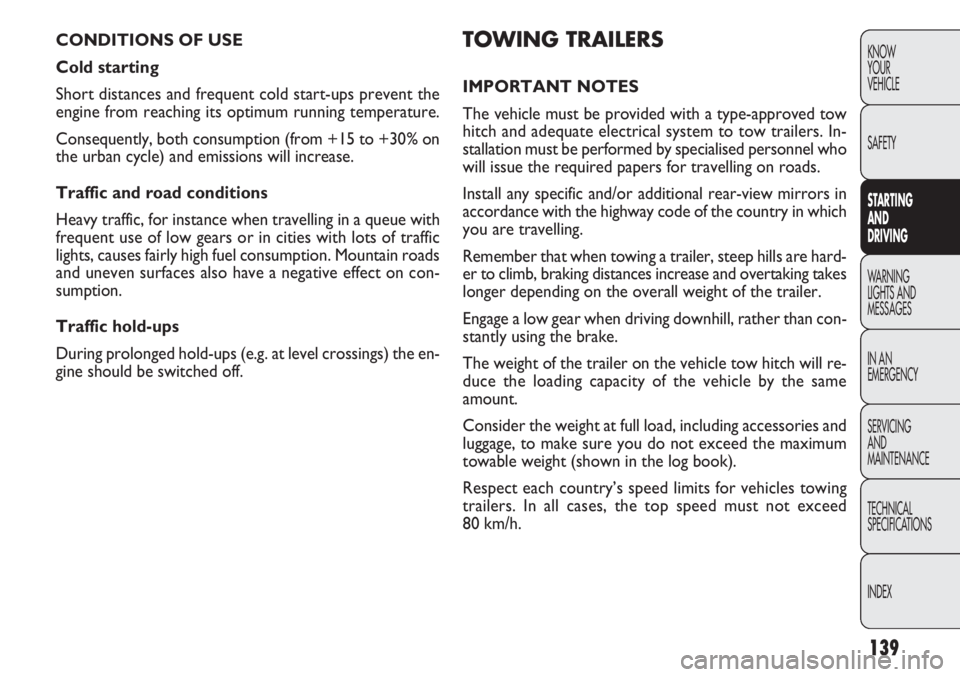
139
KNOW
YOUR
VEHICLE
SAFETY
STARTING
AN
D
DRIVING
WARNING
LIGHTS AND
MESSAGES
IN AN
EMERGENCY
SERVICING
AND
MAINTENANCE
TECHNICAL
SPECIFICA TIONS
INDEX
TOWING TRAILERS
IMPORTANT NOTES
The vehicle must be provided with a type-approved tow
hitch and adequate electrical system to tow trailers. In-
stallation must be performed by specialised personnel who
will issue the required papers for travelling on roads.
Install any specific and/or additional rear-view mirrors in
accordance with the highway code of the country in which
you are travelling.
Remember that when towing a trailer, steep hills are hard-
er to climb, braking distances increase and overtaking takes
longer depending on the overall weight of the trailer.
Engage a low gear when driving downhill, rather than con-
stantly using the brake.
The weight of the trailer on the vehicle tow hitch will re-
duce the loading capacity of the vehicle by the same
amount.
Consider the weight at full load, including accessories and
luggage, to make sure you do not exceed the maximum
towable weight (shown in the log book).
Respect each country’s speed limits for vehicles towing
trailers. In all cases, the top speed must not exceed
80 km/h.
CONDITIONS OF USE
Cold starting
Short distances and frequent cold start-ups prevent the
engine from reaching its optimum running temperature.
Consequently, both consumption (from +15 to +30% on
the urban cycle) and emissions will increase.
Traffic and road conditions
Heavy traffic, for instance when travelling in a queue with
frequent use of low gears or in cities with lots of traffic
lights, causes fairly high fuel consumption. Mountain roads
and uneven surfaces also have a negative effect on con-
sumption.
Traffic hold-ups
During prolonged hold-ups (e.g. at level crossings) the en-
gine should be switched off.
Page 144 of 283
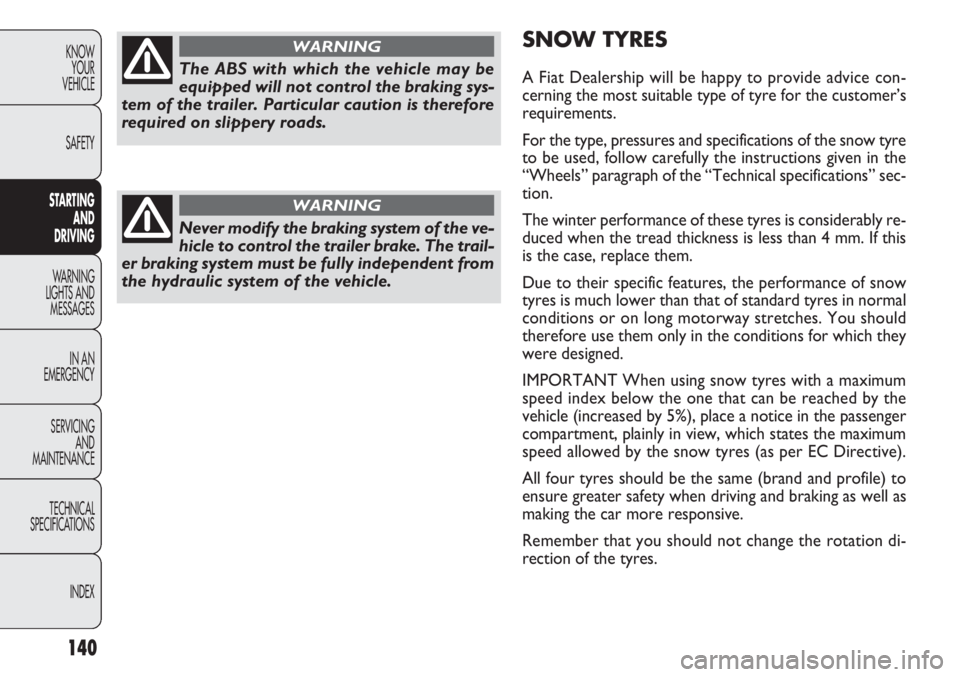
140
KNOWYOUR
VEHICLE
SAFETY
ST ARTING
AN
D
DRIVING
WARNING
LIGHTS AND MESSAGES
IN AN
EMERGENCY
SERVICING AND
MAINTENANCE
TECHNICAL
SPECIFICA TIONS
INDEX
SNOW TYRES
A Fiat Dealership will be happy to provide advice con-
cerning the most suitable type of tyre for the customer’s
requirements.
For the type, pressures and specifications of the snow tyre
to be used, follow carefully the instructions given in the
“Wheels” paragraph of the “Technical specifications” sec-
tion.
The winter performance of these tyres is considerably re-
duced when the tread thickness is less than 4 mm. If this
is the case, replace them.
Due to their specific features, the performance of snow
tyres is much lower than that of standard tyres in normal
conditions or on long motorway stretches. You should
therefore use them only in the conditions for which they
were designed.
IMPORTANT When using snow tyres with a maximum
speed index below the one that can be reached by the
vehicle (increased by 5%), place a notice in the passenger
compartment, plainly in view, which states the maximum
speed allowed by the snow tyres (as per EC Directive).
All four tyres should be the same (brand and profile) to
ensure greater safety when driving and braking as well as
making the car more responsive.
Remember that you should not change the rotation di-
rection of the tyres.The ABS with which the vehicle may be
equipped will not control the braking sys-
tem of the trailer. Particular caution is therefore
required on slippery roads.
WARNING
Never modify the braking system of the ve-
hicle to control the trailer brake. The trail-
er braking system must be fully independent from
the hydraulic system of the vehicle.
WARNING
Page 145 of 283
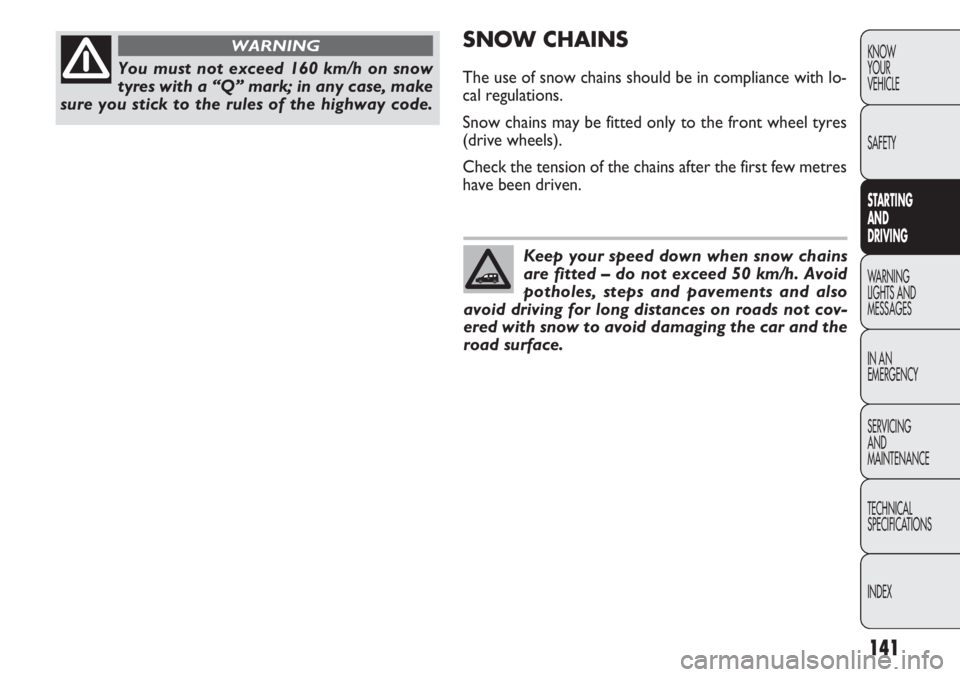
141
KNOW
YOUR
VEHICLE
SAFETY
STARTING
AN
D
DRIVING
WARNING
LIGHTS AND
MESSAGES
IN AN
EMERGENCY
SERVICING
AND
MAINTENANCE
TECHNICAL
SPECIFICA TIONS
INDEX
SNOW CHAINS
The use of snow chains should be in compliance with lo-
cal regulations.
Snow chains may be fitted only to the front wheel tyres
(drive wheels).
Check the tension of the chains after the first few metres
have been driven.You must not exceed 160 km/h on snow
tyres with a “Q” mark; in any case, make
sure you stick to the rules of the highway code.
WARNING
Keep your speed down when snow chains
are fitted – do not exceed 50 km/h. Avoid
potholes, steps and pavements and also
avoid driving for long distances on roads not cov-
ered with snow to avoid damaging the car and the
road surface.
Page 146 of 283
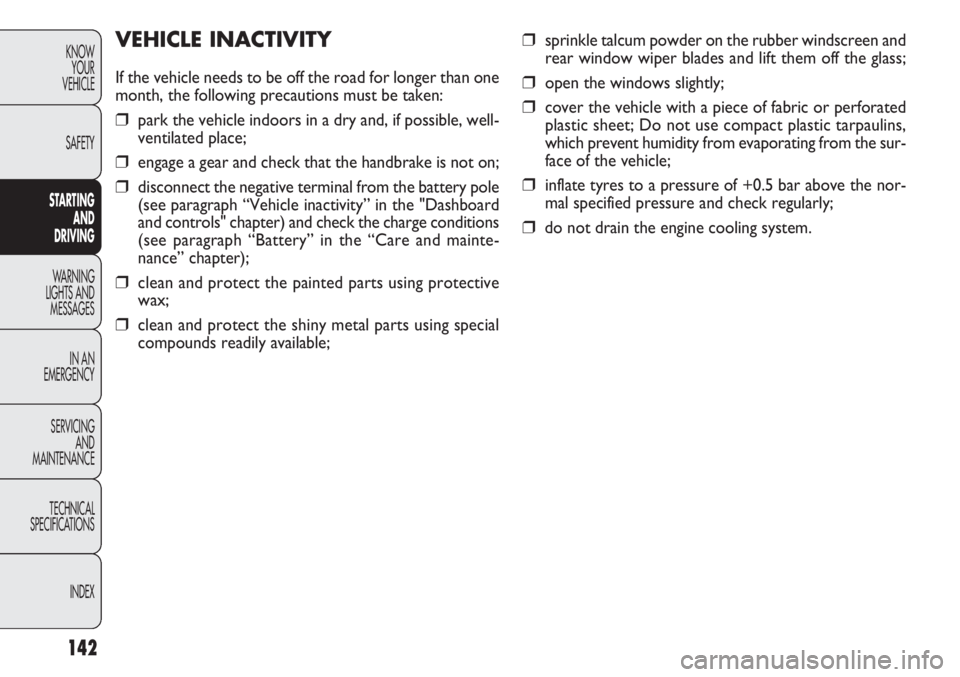
142
KNOWYOUR
VEHICLE
SAFETY
ST ARTING
AN
D
DRIVING
WARNING
LIGHTS AND MESSAGES
IN AN
EMERGENCY
SERVICING AND
MAINTENANCE
TECHNICAL
SPECIFICA TIONS
INDEX
❒sprinkle talcum powder on the rubber windscreen and
rear window wiper blades and lift them off the glass;
❒open the windows slightly;
❒cover the vehicle with a piece of fabric or perforated
plastic sheet; Do not use compact plastic tarpaulins,
which prevent humidity from evaporating from the sur-
face of the vehicle;
❒inflate tyres to a pressure of +0.5 bar above the nor-
mal specified pressure and check regularly;
❒do not drain the engine cooling system.
VEHICLE INACTIVITY
If the vehicle needs to be off the road for longer than one
month, the following precautions must be taken:
❒park the vehicle indoors in a dry and, if possible, well-
ventilated place;
❒engage a gear and check that the handbrake is not on;
❒disconnect the negative terminal from the battery pole
(see paragraph “Vehicle inactivity” in the "Dashboard
and controls" chapter) and check the charge conditions
(see paragraph “Battery” in the “Care and mainte-
nance” chapter);
❒clean and protect the painted parts using protective
wax;
❒clean and protect the shiny metal parts using special
compounds readily available;
Page 147 of 283
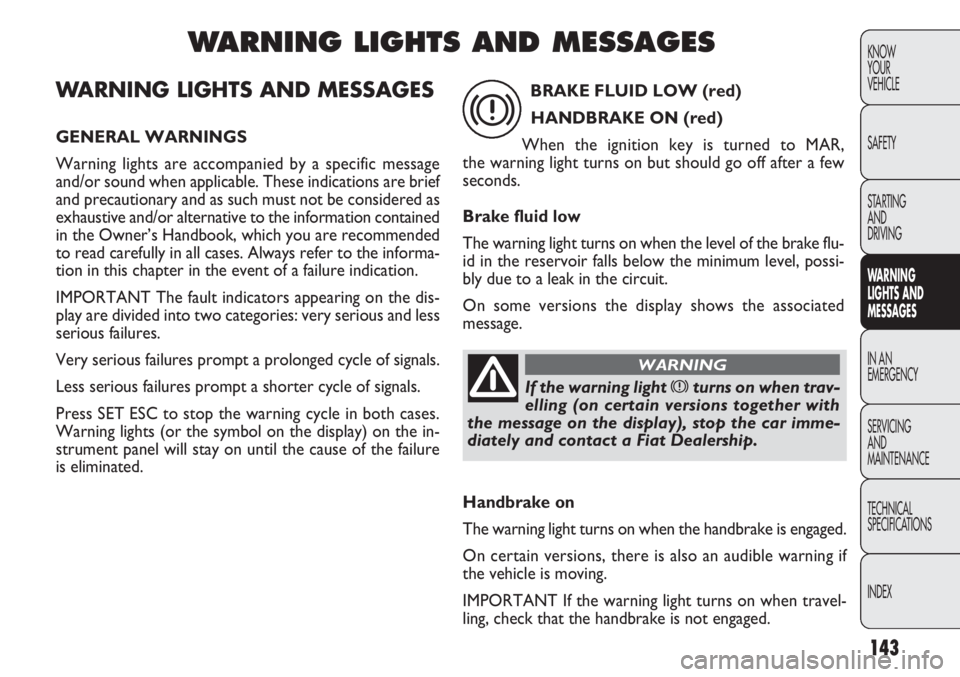
143
KNOW
YOUR
VEHICLE
SAFETY
STARTING
AND
DRIVING
WA R N I NG
LIGHTS AND
MESSAGES
IN AN
EMERGENCY
SERVICING
AND
MAINTENANCE
TECHNICAL
SPECIFICA TIONS
INDEX
WARNING LIGHTS AND MESSAGES
GENERAL WARNINGS
Warning lights are accompanied by a specific message
and/or sound when applicable. These indications are brief
and precautionary and as such must not be considered as
exhaustive and/or alternative to the information contained
in the Owner’s Handbook, which you are recommended
to read carefully in all cases. Always refer to the informa-
tion in this chapter in the event of a failure indication.
IMPORTANT The fault indicators appearing on the dis-
play are divided into two categories: very serious and less
serious failures.
Very serious failures prompt a prolonged cycle of signals.
Less serious failures prompt a shorter cycle of signals.
Press SET ESC to stop the warning cycle in both cases.
Warning lights (or the symbol on the display) on the in-
strument panel will stay on until the cause of the failure
is eliminated.
WARNING LIGHTS AND MESSAGES
If the warning light xturns on when trav-
elling (on certain versions together with
the message on the display), stop the car imme-
diately and contact a Fiat Dealership.
WARNING
BRAKE FLUID LOW (red)
HANDBRAKE ON (red)
When the ignition key is turned to MAR,
the warning light turns on but should go off after a few
seconds.
Brake fluid low
The warning light turns on when the level of the brake flu-
id in the reservoir falls below the minimum level, possi-
bly due to a leak in the circuit.
On some versions the display shows the associated
message.
x
Handbrake on
The warning light turns on when the handbrake is engaged.
On certain versions, there is also an audible warning if
the vehicle is moving.
IMPORTANT If the warning light turns on when travel-
ling, check that the handbrake is not engaged.
Page 148 of 283
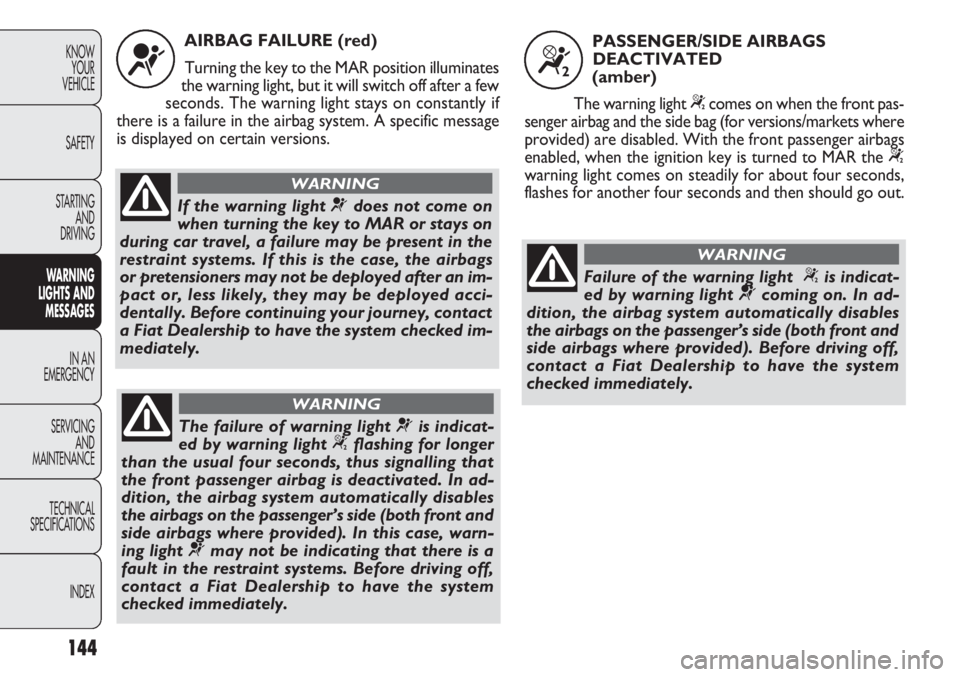
144
KNOWYOUR
VEHICLE
SAFETY
STARTING AND
DRIVING
WARNING
LIGHTS AND MESSAGES
IN AN
EMERGENCY
SERVICING AND
MAINTENANCE
TECHNICAL
SPECIFICA TIONS
INDEXAIRBAG FAILURE (red)Turning the key to the MAR position illuminates
the warning light, but it will switch off after a few
seconds. The warning light stays on constantly if
there is a failure in the airbag system. A specific message
is displayed on certain versions.
¬
If the warning light ¬ does not come on
when turning the key to MAR or stays on
during car travel, a failure may be present in the
restraint systems. If this is the case, the airbags
or pretensioners may not be deployed after an im-
pact or, less likely, they may be deployed acci-
dentally. Before continuing your journey, contact
a Fiat Dealership to have the system checked im-
mediately.
WARNING
The failure of warning light ¬is indicat-
ed by warning light
“flashing for longer
than the usual four seconds, thus signalling that
the front passenger airbag is deactivated. In ad-
dition, the airbag system automatically disables
the airbags on the passenger’s side (both front and
side airbags where provided). In this case, warn-
ing light ¬ may not be indicating that there is a
fault in the restraint systems. Before driving off,
contact a Fiat Dealership to have the system
checked immediately.
WARNING
PASSENGER/SIDE AIRBAGS DEACTIVATED
(amber)
The warning light
“comes on when the front pas-
senger airbag and the side bag (for versions/markets where
provided) are disabled. With the front passenger airbags
enabled, when the ignition key is turned to MAR the
“
warning light comes on steadily for about four seconds,
flashes for another four seconds and then should go out.
“
Failure of the warning light “is indicat-
ed by warning light
¬coming on. In ad-
dition, the airbag system automatically disables
the airbags on the passenger’s side (both front and
side airbags where provided). Before driving off,
contact a Fiat Dealership to have the system
checked immediately.
WARNING
Page 149 of 283
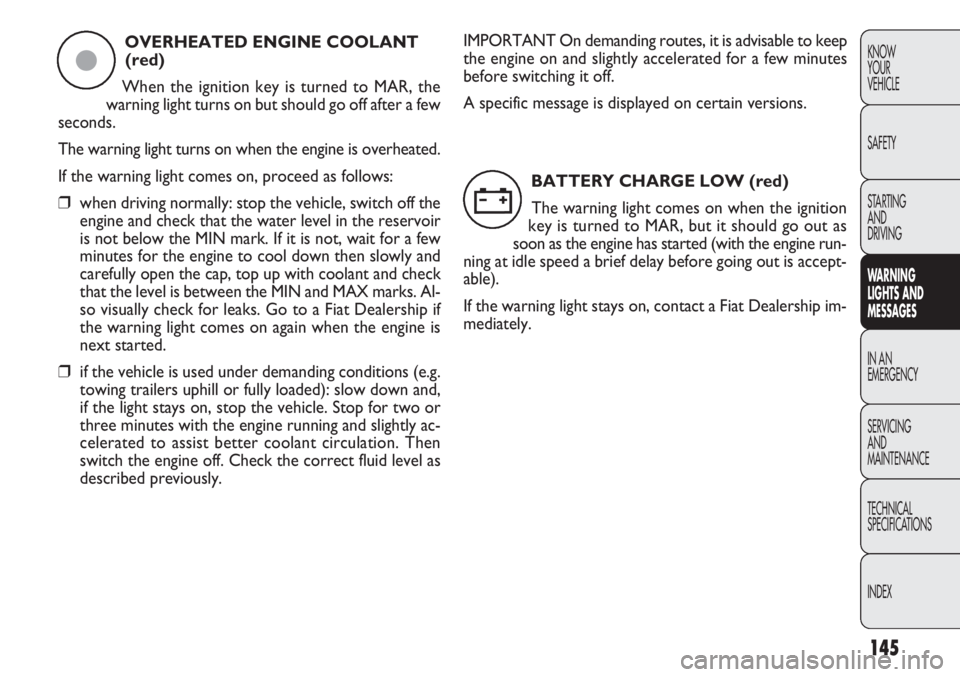
145
KNOW
YOUR
VEHICLE
SAFETY
STARTING
AND
DRIVING
WA R N I NG
LIGHTS AND
MESSAGES
IN AN
EMERGENCY
SERVICING
AND
MAINTENANCE
TECHNICAL
SPECIFICA TIONS
INDEXOVERHEATED ENGINE COOLANT (red)
When the ignition key is turned to MAR, the
warning light turns on but should go off after a few
seconds.
The warning light turns on when the engine is overheated.
If the warning light comes on, proceed as follows:
❒ when driving normally: stop the vehicle, switch off the
engine and check that the water level in the reservoir
is not below the MIN mark. If it is not, wait for a few
minutes for the engine to cool down then slowly and
carefully open the cap, top up with coolant and check
that the level is between the MIN and MAX marks. Al-
so visually check for leaks. Go to a Fiat Dealership if
the warning light comes on again when the engine is
next started.
❒ if the vehicle is used under demanding conditions (e.g.
towing trailers uphill or fully loaded): slow down and,
if the light stays on, stop the vehicle. Stop for two or
three minutes with the engine running and slightly ac-
celerated to assist better coolant circulation. Then
switch the engine off. Check the correct fluid level as
described previously.
ç
IMPORTANT On demanding routes, it is advisable to keep
the engine on and slightly accelerated for a few minutes
before switching it off.
A specific message is displayed on certain versions.
BATTERY CHARGE LOW (red)The warning light comes on when the ignition
key is turned to MAR, but it should go out as
soon as the engine has started (with the engine run-
ning at idle speed a brief delay before going out is accept-
able).
If the warning light stays on, contact a Fiat Dealership im-
mediately.
w
Page 150 of 283
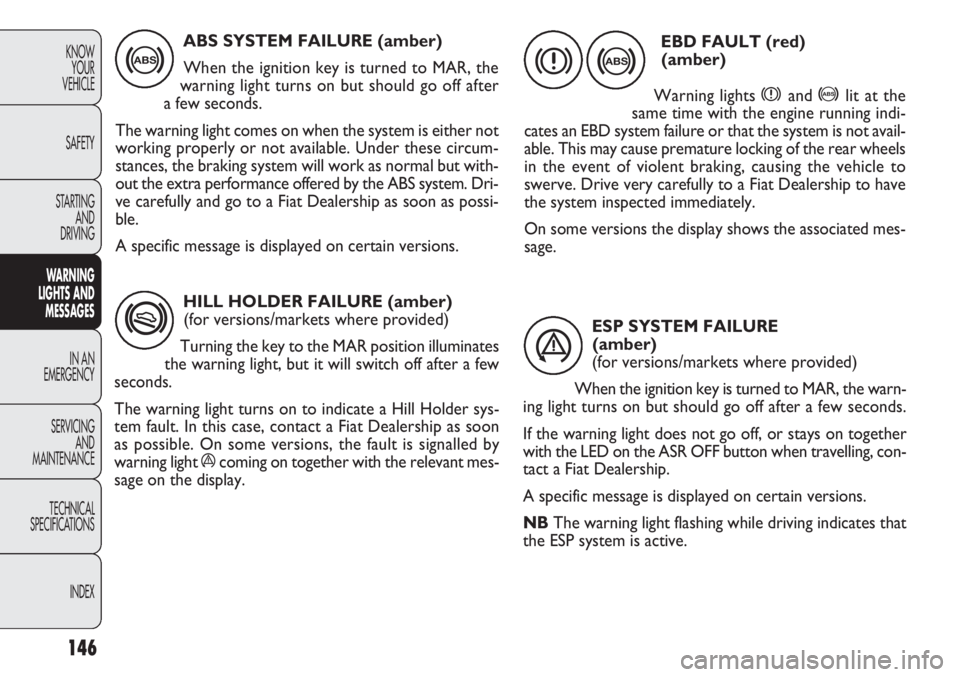
HILL HOLDER FAILURE (amber)(for versions/markets where provided)
Turning the key to the MAR position illuminates
the warning light, but it will switch off after a few
seconds.
The warning light turns on to indicate a Hill Holder sys-
tem fault. In this case, contact a Fiat Dealership as soon
as possible. On some versions, the fault is signalled by
warning light á coming on together with the relevant mes-
sage on the display.
*
ABS SYSTEM FAILURE (amber)
When the ignition key is turned to MAR, the
warning light turns on but should go off after
a few seconds.
The warning light comes on when the system is either not
working properly or not available. Under these circum-
stances, the braking system will work as normal but with-
out the extra performance offered by the ABS system. Dri-
ve carefully and go to a Fiat Dealership as soon as possi-
ble.
A specific message is displayed on certain versions.
146
KNOW YOUR
VEHICLE
SAFETY
STARTING AND
DRIVING
WARNING
LIGHTS AND MESSAGES
IN AN
EMERGENCY
SERVICING AND
MAINTENANCE
TECHNICAL
SPECIFICA TIONS
INDEX>
EBD FAULT (red) (amber)
Warning lights
xand >lit at the
same time with the engine running indi-
cates an EBD system failure or that the system is not avail-
able. This may cause premature locking of the rear wheels
in the event of violent braking, causing the vehicle to
swerve. Drive very carefully to a Fiat Dealership to have
the system inspected immediately.
On some versions the display shows the associated mes-
sage.
>
x
ESP SYSTEM FAILURE
(amber)
(for versions/markets where provided)
When the ignition key is turned to MAR, the warn-
ing light turns on but should go off after a few seconds.
If the warning light does not go off, or stays on together
with the LED on the ASR OFF button when travelling, con-
tact a Fiat Dealership.
A specific message is displayed on certain versions.
NB The warning light flashing while driving indicates that
the ESP system is active.
á